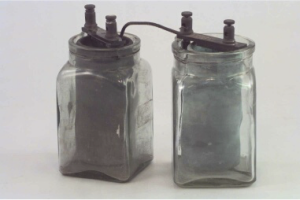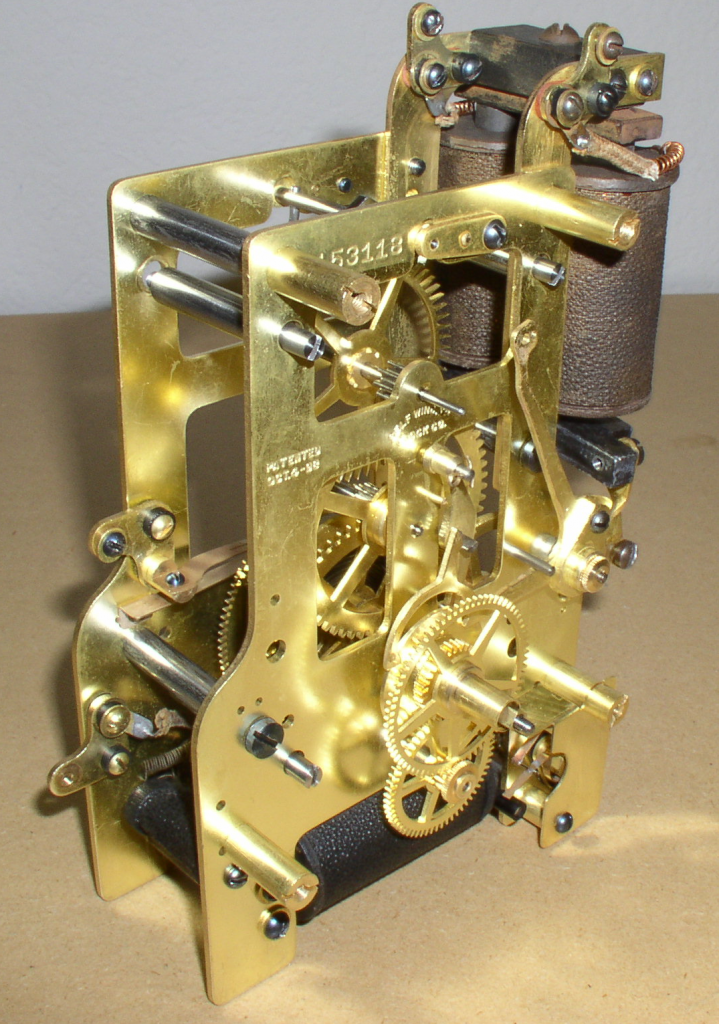From the late 1800’s until well into the mid 1900’s, self-winding clocks earned a most important role in horological history. They provided robust and reliable time synchronization across the country. They serviced railroads and other transportation industries, factories, schools, retail stores, and other businesses. Most were leased to these customers (for a monthly fee of $1.25 to $2.00 per clock initially), with service contracts to maintain them on a regular basis.
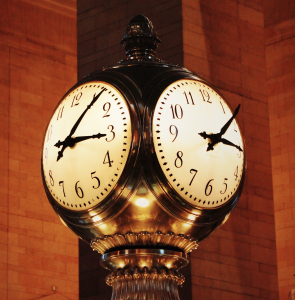
In the 1890’s, Chester Henry Pond (considered the inventor of the self-winding clock) had two ingenious ideas: First, he designed a clock movement that could be wound by an electric motor powered by batteries, thus eliminating the concern that the clock would stop due to lack of manual winding. Second, he envisioned linking timekeeping with the expanding Western Union telegraph communications network. By discontinuing all telegraph transmissions a few minutes before noon every day, this national WU telegraph network could be used to send synchronization signals to master clocks all over the United States! Receiving clocks along the network were equipped with electromagnetic coils and a linkage to the hands to “force reset” the hands to the hour in response to the noontime WU signal.
This was truly revolutionary at the time, because it created a nationwide time synchronization standard, which allowed transportation industries and businesses to coordinate events across distances to a degree previously unavailable. Locally, “secondary” clocks could be similarly linked to these master clocks, which brought the advantages of this synchronized time network to a local level. Now, factories, schools, retail stores, town centers, etc. could all provide accurate timekeeping for people. This relationship with Western Union was extended to include battery and clock maintenance by Western Union.
Power for many self-winding clocks originated with Georges Leclanche’s 1866 invention of the carbon-manganese-dioxide and zinc battery. They generally used a pair of these 1.5 volt cells to provide the necessary 3 volts for the clocks. Leclanche batteries were clumsy and messy to set up because they involved mixing chemicals on site, but they worked rather well. By the late 1890’s, a pair of 1.5 volt No. 6 Columbia Dry Cells became the premier power source for these clocks.
The master signal for this noontime synchronization originated from the Naval Observatory Laboratories in Washington DC, where astronomical instruments had been used to determine exact time for decades prior. Since the mid-1840’s, a time ball at the top of the Naval Observatory building was dropped at exactly 12:00pm, allowing ships at the ports near Washington to set their onboard timepieces. Local residents took advantage of this as well. Further, noontime telegraph signal services were being sold locally for many years for manual resetting of timepieces. Master clocks on site were soon commissioned to provide the time references, which were sent out via the Western Union network. This system continued to evolve in terms of automation and accuracy well into the 1960’s, until newer and even more accurate methods of precision time synchronization emerged, such as cesium atomic standards and NIST WWVB transmissions. Slowly the self-winding clock with Western Union synchronization drifted towards becoming the obsolete technology.
After WWII, Western Union’s fleet of service engineers started to become a burdensome cost. Into the late 1950’s, service periods were extended, clocks were neglected, and customer complaints mounted. Self Winding Clock Co. eventually sued WU for breach of contract. To settle the suit, SWCC assets were purchased by WU and, in time, liquidated. As stories from ex-WU employees recount, the clocks were collected up and many destroyed, along with most of the records associated with the history of how the company was run. But some clocks survived. Many of these surviving clocks decommissioned by the late 1960’s have been slowly finding their way into the caring hands of horological collectors.
These fortunate collectors find great pride of ownership with self-winding clocks. Many competitive companies emerged along with Self Winding Clock Company of New York. In particular, those manufactured by Standard Electric Time Company, ITR and Stromberg to name a few, were all built to last. Cases are built of high-quality select grades of lumber with intricate carvings, appointed with heavy-duty hardware throughout, and beveled glass. Movements are well-built, with thick plates and rugged construction. Unfortunately after nearly 100 years, the clock movements (and sometimes cases) require some attention to assure continued reliable operation.
Movement Serial Numbers. One very commonly asked question is, “How old is my clock based on the serial number?” Unfortunately, there are no original records in existence to assist with this determination; there are only trends and tendencies. What makes matters worse is that movements and movement serial number tags were often replaced as a means of maintaining the clocks.
Rather obviously, lowest serial numbers are the earliest, and the higher are the newest. We have observed that 2 to 4-digit serial numbers were associated with earliest Style A/B/C movements, although 5-digit serial numbers under 30,000 are found there too. Early Style F serial numbers have been observed in the 33,000 range. 6-digit serial numbers are likely post 1920, and 200,000+ are likely post 1930. We’ve seen 300,000+ serial numbers associated with many Broadcast Studio clocks produced since the WWII, some with FR prefixes. There are also known gaps in the serial number system.
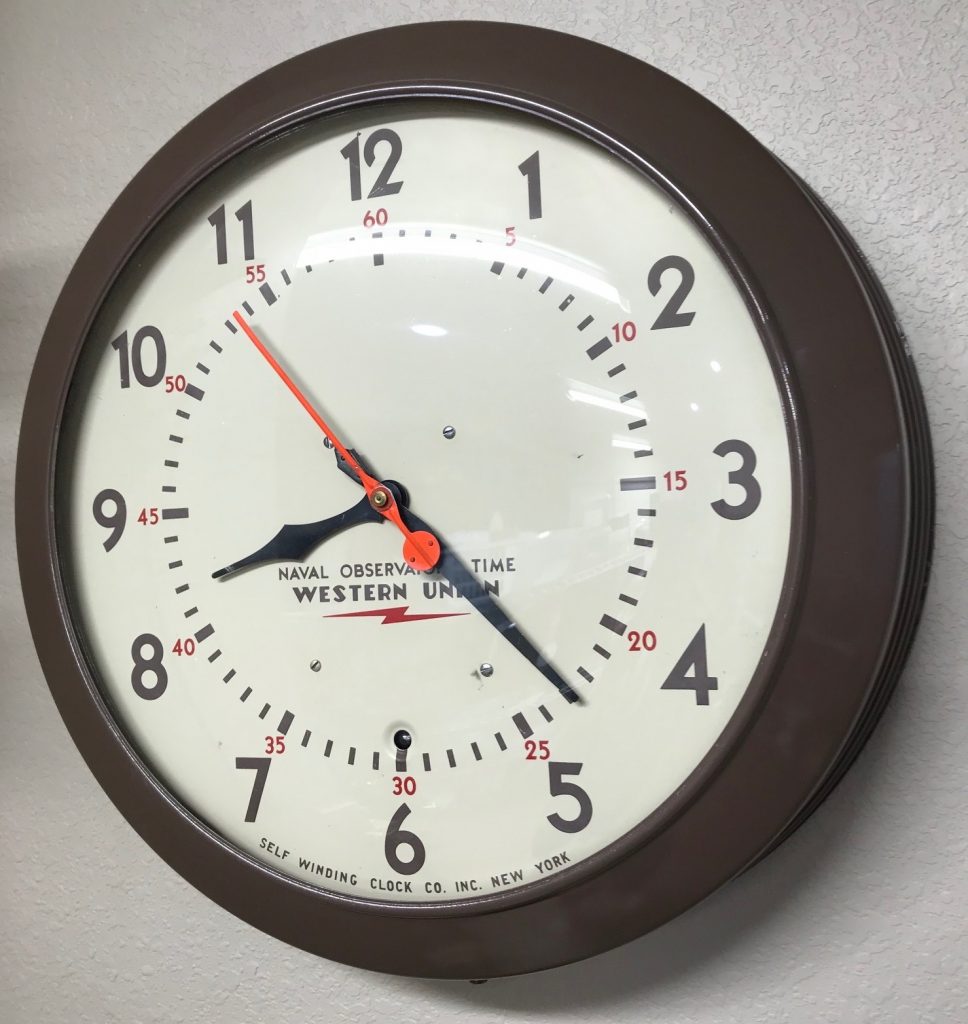
The newer Broadcast Studio clocks utilized aluminum battery holders, and are often 5-minute wind units. Most recent models used a German-manufactured die-cast motor that wound in less than 2 seconds (to eliminate the vibrating sounds which were disturbing in studios), and were likely produced after 1950. As we learn more about this topic, we will continue to add to this post.
For a deeper dive on this “dating” topic, you might also want to consider an excellent and very detailed article by J. Alan Bloore which chronicles the development of the Style F movement with some interesting and relevant references to serial number range history based on his independent observations and study. Our observations seem to at least correlate with his.
About our Restorations. Ken’s Clock Clinic offers professional restoration of self-winding clocks. Our clients expect authentic restorations. We provide Style F movement restoration covering all electrical, mechanical components. The movement will be disassembled and individual components cleaned to remove all grease and oxides. Worn pivots and holes will be restored. Bushings are neat and undetectable. Worn pinions are likewise addressed. Style A/B/C movement restorations include precision replication of missing or damaged motor parts. Restoration processes for other self winding clocks are similar to those mentioned. We keep a library of original manufacturers’ specifications and data for many of the clocks serviced, much of which has been created from studying original parts over the years.
Authentic restoration includes electrical components. Either due to wear, abuse, or incorrect voltages, contacts and resistors may be damaged. Original spool-wound resistors will be restored exactly like the originals. Coil bobbins and end caps are fabricated to replicate originals as needed. All contacts are cleaned and inspected. When necessary, these will be replaced. We provide contact replacement using only pure platinum, palladium, gold or silver wire and foil as was used previously. If necessary, electromagnets can be rewound with original silk-covered magnet wire.
Despite the many requests we receive, parts for self winding clocks are generally unavailable. Those very few which are available from commercial suppliers are often inadequate. In general, so many horological replacement parts are manufactured in China and India and while they are available at a low price, quality is lost. We fabricate replacement mainsprings, contacts, precision escape wheels and verges, suspension components, winding ratchet wheels, and even many pendulum parts to name a few. This assures that original quality is returned to your fine timepiece. We are the only self winding clock service to offer this level of painstaking detail, anywhere in the world. Some of these parts we make available through our e-store, but many are fabricated as needed during the restoration process.
We will provide our clients with details of all work done–even during the process, if requested.
We warranty our movement restorations for 2 years if the clock is subsequently powered with our Vintage Dry Cell Battery Replacements, either alkaline or rechargeable. Using these products we can be assured that the proper voltage is being used to power your restored clock.
Periodically, customers purchase our battery products, install them in the clock, and the clock still does not wind and run. This is a clear sign that the clock probably stopped due to wear out. Our Most Frequently Asked Question explores this issue in depth.
We have repaired many clocks which were unfortunately run with 6 volt lantern batteries or other DIY power sources not appropriate for 3 volt clocks. This can cause cumulative damage to both the electrical and mechanical components. For this reason, Ken’s Clock Clinic provides the 1900 series Vintage Dry Cell Battery Replacements to assure that the historic value of these clocks will be conserved for generations to come.
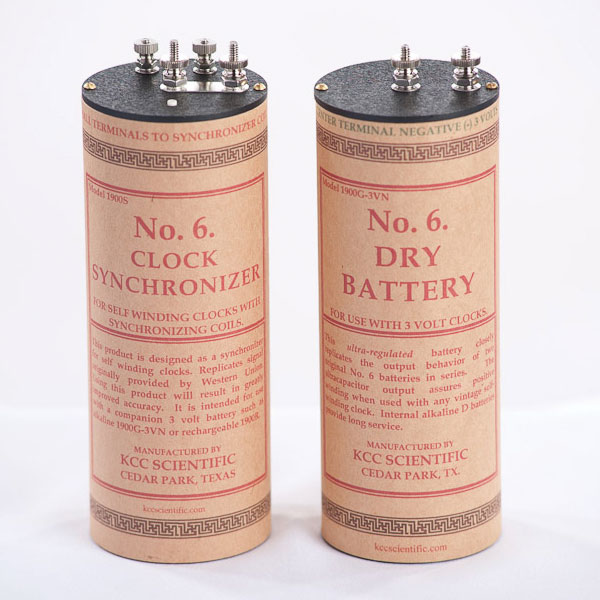
Note to customers who wish to power the clock from homebrew supplies after our restoration services are performed:
Keep in mind that the power source and the clock are a system and must be designed to work with each other. Our policy with customers wishing to power their own clocks is that we cannot provide our 2 year warranty. We cannot possibly warrant a movement when we don’t know what is powering it. There is a big difference between putting together a one-off voltage source versus a time-tested design that has been thought through with decades of experience and understanding in powering vintage clocks. The clock as a load is not resistive. The platinum can be burned up in less than a year and other components over-stressed resulting in a damaged winding mechanism due to improper power sources. At the very least, multiple trips back to our shop for contact cleaning and maintenance would easily cost more than the proper battery system from us.
Our experience with both restoring and powering early self-winding electrics includes clocks manufactured by the Self Winding Clock Company, Standard Electric Time, New York Standard Watch Company, American Clock Company, Stromberg, Poole, Sempire, Gregory, Bulle, numerous ATO styles, and many others.
For more information on our restoration services, please contact us.
Shipping: Please see our Shipping Instructions found here. Important: Standard policy is to bill at time of shipping. Therefore RESTORATION ESTIMATES DO NOT INCLUDE SHIPPING, PACKING OR INSURANCE COSTS.
